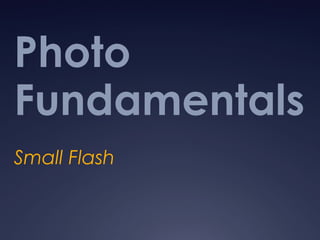Report
Share

Recommended
More Related Content
What's hot
What's hot (20)
Understanding Exposure: Learn How to Achieve Perfectly-Exposed Photos

Understanding Exposure: Learn How to Achieve Perfectly-Exposed Photos
Similar to Small flash
Similar to Small flash (20)
THE PERFECT GUIDE TO HELP YOU MASTER YOUR NIKON D-SLR

THE PERFECT GUIDE TO HELP YOU MASTER YOUR NIKON D-SLR
Digital Photography Fundamentals : Aperture, Shutter Speed and Perspective

Digital Photography Fundamentals : Aperture, Shutter Speed and Perspective
More from jduchesne
More from jduchesne (6)
Recently uploaded
Recently uploaded (20)
Repurposing LNG terminals for Hydrogen Ammonia: Feasibility and Cost Saving

Repurposing LNG terminals for Hydrogen Ammonia: Feasibility and Cost Saving
Web Form Automation for Bonterra Impact Management (fka Social Solutions Apri...

Web Form Automation for Bonterra Impact Management (fka Social Solutions Apri...
AWS Community Day CPH - Three problems of Terraform

AWS Community Day CPH - Three problems of Terraform
Connector Corner: Accelerate revenue generation using UiPath API-centric busi...

Connector Corner: Accelerate revenue generation using UiPath API-centric busi...
How to Troubleshoot Apps for the Modern Connected Worker

How to Troubleshoot Apps for the Modern Connected Worker
Apidays New York 2024 - Passkeys: Developing APIs to enable passwordless auth...

Apidays New York 2024 - Passkeys: Developing APIs to enable passwordless auth...
Navigating the Deluge_ Dubai Floods and the Resilience of Dubai International...

Navigating the Deluge_ Dubai Floods and the Resilience of Dubai International...
Emergent Methods: Multi-lingual narrative tracking in the news - real-time ex...

Emergent Methods: Multi-lingual narrative tracking in the news - real-time ex...
Polkadot JAM Slides - Token2049 - By Dr. Gavin Wood

Polkadot JAM Slides - Token2049 - By Dr. Gavin Wood
ProductAnonymous-April2024-WinProductDiscovery-MelissaKlemke

ProductAnonymous-April2024-WinProductDiscovery-MelissaKlemke
ICT role in 21st century education and its challenges

ICT role in 21st century education and its challenges
Boost Fertility New Invention Ups Success Rates.pdf

Boost Fertility New Invention Ups Success Rates.pdf
Small flash
- 1. Photo Fundamentals Small Flash
- 2. Benefits of using flash Convenient Stops motion of moving subjects (burst usually between 1/1000 second and 1/8000 second) Prevents blur caused by hand holding Portable, predictable, measurable, repeatable Very consistent in brightness and color
- 3. Flash Facts Everyone Must Know! Every flash exposure is two exposures in one. Aperture controls flash – Shutter speed controls available light. Flash exposure is not affected by shutter speed (except when using “high speed sync). Flash illumination is dramatically affected by distance (inverse square law, aka “falloff”). Cameras measure ambient light and flash illumination separately.
- 5. More Facts Everyone Must Know! Every SLR camera with a mechanical focal plane shutter has a maximum flash shutter speed (1/250 second on current DSLRs). High Speed Sync allows you to use wide apertures and fast shutter speeds while still using flash. f-stop = GN / distance or Distance = GN / f-stop A Guide Number must contain a distance unit and an ISO value (580EX II: 190 feet / 58 Meters at ISO 100).
- 6. Basic Flash Techniques The easiest way to light a scene with flash is with direct flash on a camera (a built in or flash unit mounted directly on the camera and pointed directly at the subject). Although this will produce a properly exposed photograph, they tend to be flat (in modeling and texture), shadowless, and two dimensional The reason for this is not a fault of the flash, but its position in relation to the lens (the cause of red eye too) A flash that you can use from off camera offers more lighting options.
- 7. Basic Flash Techniques cont… Control is limited when using a built in flash, A small flash units that connect to the camera’s hotshoe allows far greater control. Most hotshoe flash units have a swivel head which allows you to bounce the flash off a wall or a low ceiling, diffusing the light to give the subject softer shadows. Flash bursts are too short to see how the light will be recorded on film so carefully aim the flash at your subject. The use of a flash meter may also be necessary.
- 8. Basic Flash Techniques cont… By taking the flash off camera and altering its position, various lighting styles can be achieved to produce more natural looking results with a less obvious “flash” look. Holding the flash above the subject more closely resembles natural lighting and increases the feeling of depth.
- 9. Attachments
- 10. More Attachments
- 11. The Result
- 14. Automatic Flash Manual mode means on automatic flash units means full power. Some have manual control settings such as ½, ¼, 1/8, 1/16, 1/32, 1/64 and 1/128. When using the automatic Thyristor feature, you must select one of the available aperture settings as indicated by the flashes “calculator” and set it manually. The flash will measure the light reflected from the subject during the exposure and cut off the flash when exposure is correct. You must remain within the specified distance range displayed in the “calculator”.
- 17. TTL and E-TTL TTL stands for Through The Lens. It works exactly like and automatic flash except it uses the camera sensor/meter (instead of a flash mounted thyristor) to adjust the flash power for correct exposure. E-TTL stands for Evaluative Through The Lens. It uses a brief pre-flash before the main flash in order to obtain a more correct exposure.
- 25. References Photography Textbook – Pages 234 to 243 http://photography-on-the.net/forum/showthread.php?t= http://photography-on-the.net/forum/showthread.php?t= http://strobist.blogspot.com/2007/12/guide-number-your-